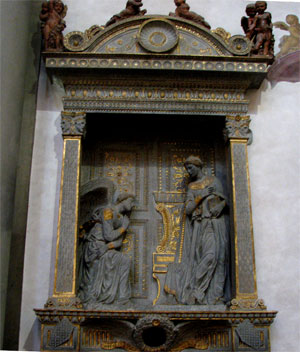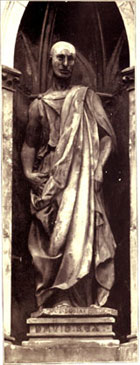Donatello
Donatello, the greatest Tuscan sculptor until Michelangelo, was not one of the competitors for the bronze gates of the Baptisery, but is said to have been consulted by the judges, although he was only sixteen at the time.
He has been apprenticed to a goldsmith, probably to the step-father of Ghiberti, and, when he accompanied Brunelleschi to Rome, he supported himself by his trade, while he made an exhaustive study of every place of antique sculpture that he could find, at the same time exhuming fragments of capitals and bas-reliefs; and he managed to take back with him an invaluable collection.
But while imbued with the severity of classical models, Donatello was intensely original in his work, especially in his power of conveying expression and in his treatment of hair.
The ruling motives in Florence sculpture were more Gothic, and Donatello received his earliest training in this school. Although he learned a lot from the classics, his sculptures always retained a specific character with little influence from the essential elements of classical art, as proven by his Magdalen in the Duomo and his Crucifix in Santa Croce, both carved in wood.

Donatello: Annunciation
Santa Croce, Florence
Sculptures at Orsanmichele and Campanile
After his return from Rome, we find Donatello closely connected with the Opera del Duomo or the Cathedral Board of Works. For this body and for Orsanmichele, the Church of Merchants, the artist will create some of his finest sculptures. The first recorded payment to Donatello by the Cathedral authorities, was made in November 1406.
He was engaged on three statues for Orsanmichele, St. Peter, St. Mark and St. George, the latter being a veritable masterpiece.
The Florence Cathedral was not yet completed, and great importance was placed on finishing the construction which was intended to be the symbol of the city. In the process, there was a danger of sculptors being considered second rank artists and thus subordinated to the architects. However, they preserved their freedom in adapting to the existing architectural lines. It is precisely in the statuary applied to the completed Cathedral building that we can trace the most interesting transitions from Gothic to Renaissance.
The Campanile is adorned by sixteen statues, four on each side of the tower. In themselves, the statues epitomize the early Florentine sculpture.
The Cathedral sculptures, with the exception of St. John the Baptist and St John the Evangelist, are derived from the Old Testament: Daniel, Jeremiah, Abraham and the marble David in the Bargello together with the two figures popularly called Poggio and the Zuccone (Habakkuk), the bald-headed prophet who, with three other prophetic figures, adorned the Baptistery side of the Campanile. This statue is known to have been Donatello's favorite, and he was wont to swear: "By the faith that I bear to my Zuccone." It is now in the Museo dell'Opera del Duomo in Florence.
Two sculptures in the Duomo representing prophets are interesting as being portraits of Giannozzo Manetti and Poggio Bracciolini.
The two galleries of Donatello and Luca della Robbia, completed in 1440 reveal another faculty of the former artist: his power of judging of the effect of distance which he possessed in a remarkable degree, and which makes the work in question far more effective and striking than that of della Robbia.
Padua sculptures
In 1448, Donatello went to Padua, a centre of intellectual and humanistic activity, where he created the famous equestrian statue of Gattamelata.
Donatello had to represent the anatomy of the horse on a colossal scale. The "Condottiere" statue was a formidable task of making the first equestrian bronze statue in Italy during the Renaissance. It was even more difficult as no model existed except the Emperor Marcus Aurelius statue at Rome.
In Padua he also did bronze reliefs and statues for the Basilica of San Antonio which are considered to have a major influence upon the Paduan school of art.
He was old when he left the city. Before his departure, he completed the greatest undertaking of his career: the High Altar at the Santo, with marble settings and bronze figures. The great work was composed of a Crucifix, the Madonna and Child, six saints, a Pietà, twelve panels representing Angels, four reliefs of St. Anthony's Miracles, the Symbols of the Evangelists, and a marble Entombment.

Zuccone by Donatello
Sculptures created for Cosimo de' Medici
Donatello's character was no less interesting than his work. Never was any man more indifferent to material things; riches, food, clothes, comfort, seemed to mean nothing to him. His money he kept in a basket in order that anyone might come in and take what he wanted; his name was a by-word for generosity.
Cosimo de' Medici was rather his friend than his patron, for it was difficult for such a man to have a patron. Cosimo made him a present of a farm thinking that the proceeds of it would insure him against poverty, but, after a short time, the sculptor returned the gift, saying he did not wish to be burdened with it; his friend then took the wiser course of allotting him a sum of money to be paid weekly by the bank, sufficient to maintain him and four apprentices.
As regards clothing, Cosimo finding that he was too shabbily dressed, had a complete suit of red made for him, and sent it on the morning of a festival; but Donatello wore it only once or twice, and then returned it. It was too fine for him. After this, Cosimo wisely replaced his worn-out things bit by bit, in such a manner the recipient never realized that he was wearing anything new.
Donatello's finest statues, the bronze David and the Judith and Holofernes, were wrought for Cosimo, and there are also some fine medallions of his in the court of the Medici Palace (now Palazzo Medici Riccardi).
In his last years he worked entirely in San Lorenzo; the bronze doors of the Sacristy and many works within are his; also the two pulpits were designed and partly carried out by him.
Donatello outlived Cosimo two years and by his own request was buried in the same vault with him: it was an ideal friendship. Donatello's funeral was attended by a vast concourse of Florentines and by all the artists in the city, all of whom had been his friends and many his pupils, and there could have been few who had not benefited by his generosity.